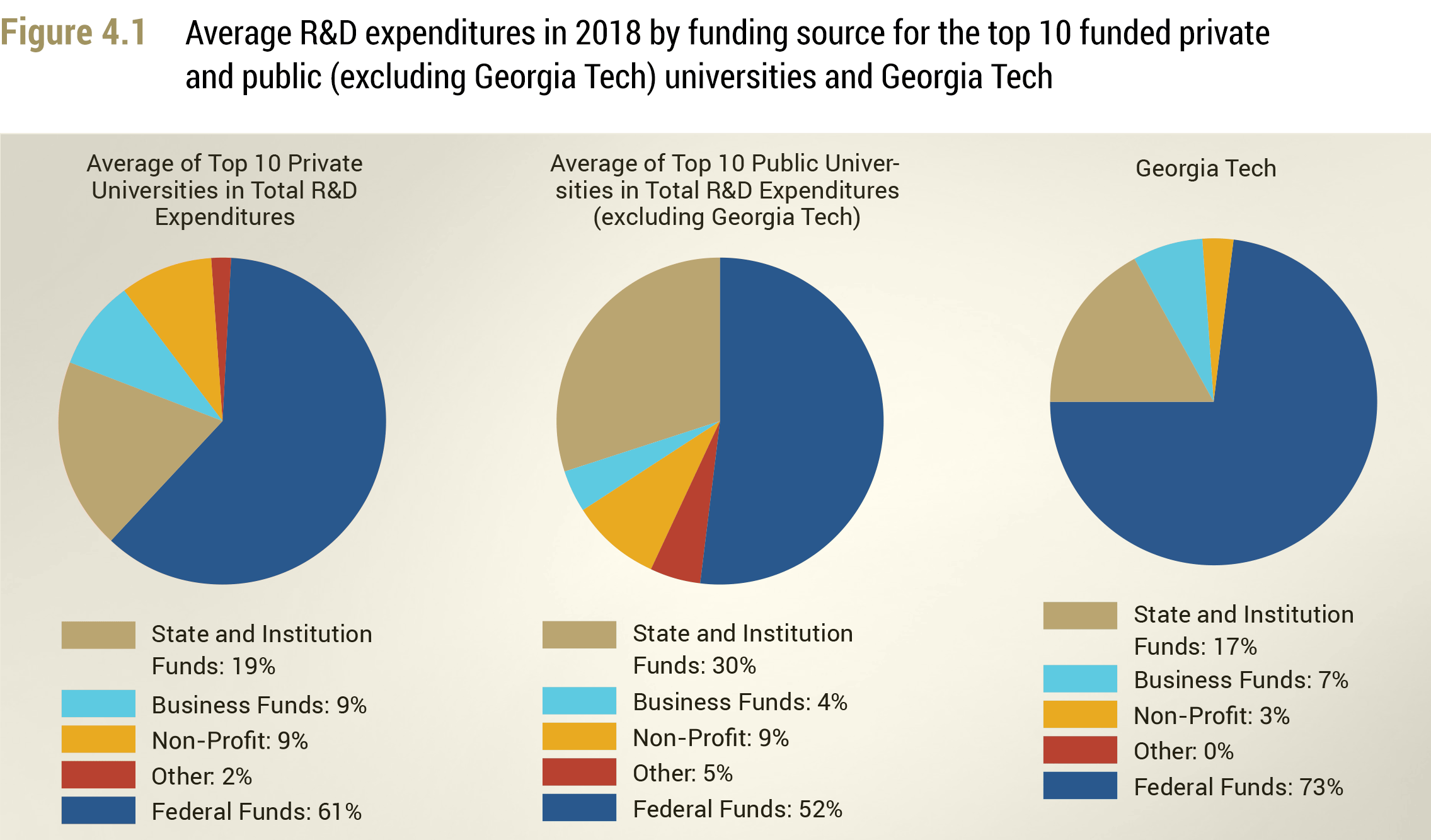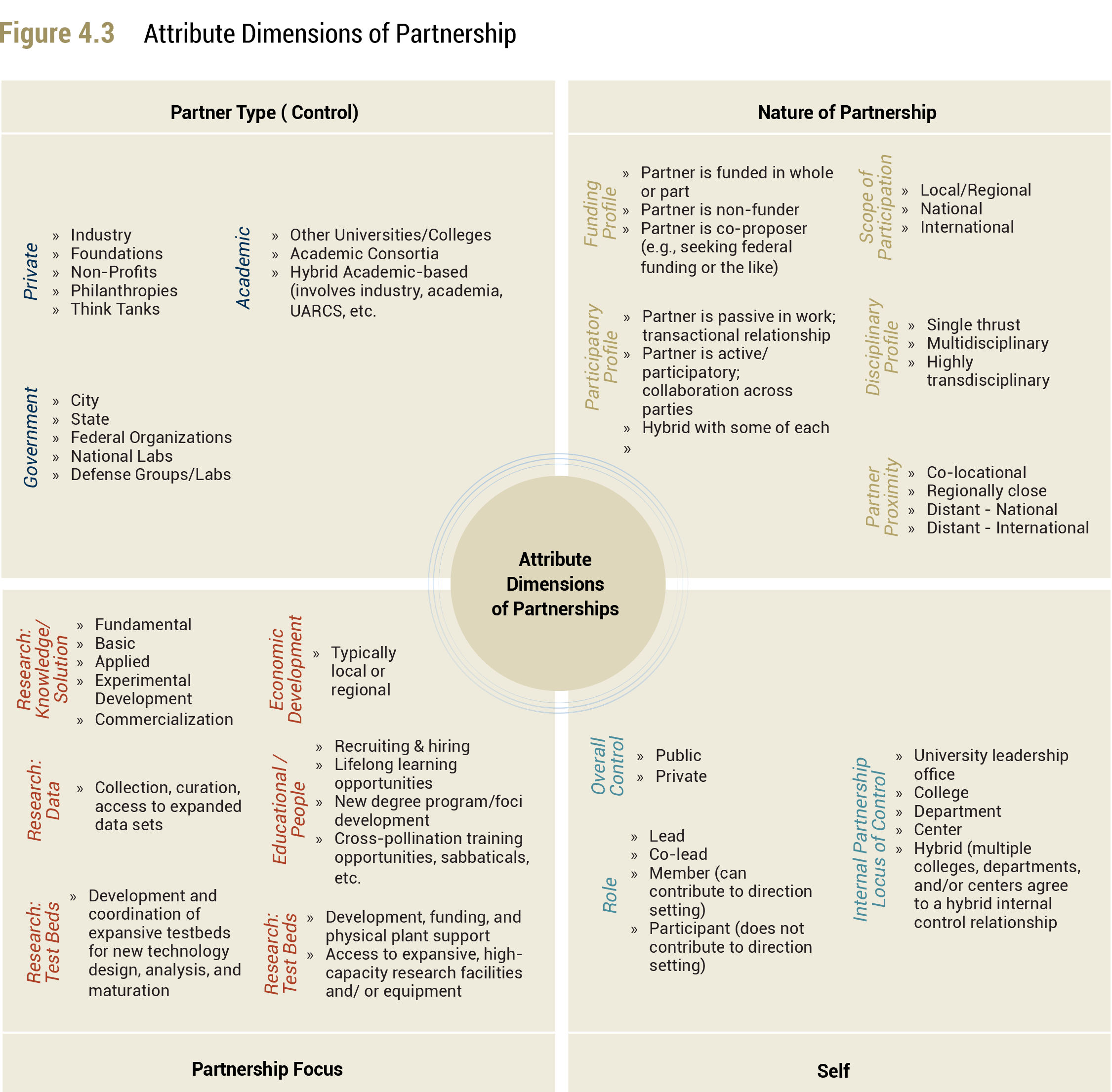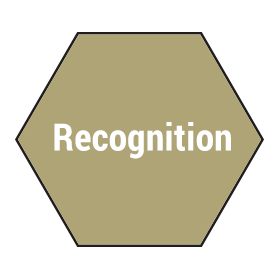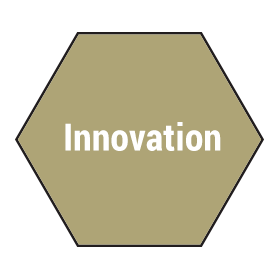4.1 Introduction
The very nature of the societal challenges with which research universities must engage require collaboration and partnership. Increasingly, we must become more deeply integrated within the broader ecosystem of governments, companies, and local communities — and a leader in establishing and nurturing these partnerships. This chapter focuses on university partnerships, analyzing how research universities can cultivate a portfolio of purposeful strategic relationships, amplifying impact across individual, institutional, city, regional, national, and global dimensions.
This chapter was guided by the questions:
- What is driving universities to seek out more — or more meaningful — strategic partnerships?
- What factors affect the ability of universities to form successful collaborations, and what might the nature of these relationships look like in the future?
- What are primary considerations for universities seeking to employ strategic partnerships to amplify their impact?
These questions themselves are contextualized within the distinct attributes of a given research university. Returning to the Carnegie classification data described in Chapter 1, Georgia Tech is one of 25 institutions in the U.S. that are classified as very high research activity, public, comprehensive or STEM-focused at the doctoral level, and without a medical or veterinary school. That lens is important to understand the considerations for partnership, as the flavor of implementation must be driven by their unique mission and setting. Public universities, for example, are subject to different constraints than private ones, and institutions classified as or striving to be classified as very high research activity universities have goals and pressures beyond, but complementary to, the educational mission.
4.2 Elements That Influence Partnerships
Financial Environment and Defining a University’s Niche
Fundamentally, finances drive strategic collaboration across many sectors, and higher education is no exception. Public institutions rely on state appropriations, which implies a local or regional impact responsibility and may constrain other activities, such as setting tuition or entering into legal agreements. As shown in Table 1.2, state R&D expenditures in universities fluctuated slightly, but generally decreased as a percentage of the total R&D expenditures over the past decade.
While state funds primarily support Institute operations, federal funds are typically directed to student support and research. Augmenting the data from Tables 1.1. and 1.2 with a recent Pew Institute analysis [Pew 2019], nearly 75% of total federal research funding to public colleges and universities in 2017 went to 16% of those schools. To gain a different perspective, we looked at the relative contributions of the R&D funding sources in 2018 [HERD 2018], averaging among the top ten private universities and the top ten public universities (excluding Georgia Tech), comparing them with the R&D expenditures at Georgia Tech. As shown in Figure 4.1, the top 10 private institutions and the top 10 public institutions, on average, had equal R&D expenditure funded by NGO and roughly equal (about 80%) combined R&D expenditures from federal, state and institution sources. Georgia Tech, by comparison, had a much higher share from federal, state, and institution sources combined and notably lower shares in other sources. In addition, Georgia Tech’s share of business funds was more similar to that of the average of the private institutions than the average of the public institutions.

Data source: HERD 2018 Table 5: https://ncsesdata.nsf.gov/herd/2018
As seen in Table 1.1, following years of consistent increases in the commercial sector, industry performed and funded most of U.S. R&D, including basic, applied, and experimental development [NSB 2020a, Sargent 2020]. By 2017 industry accounted for approximately 29% and 27% of basic research funded and performed, respectively, and just over half of all applied research, as illustrated in Figure 4.2. Additionally, of the total R&D funding in 2017, more than 80% went to research designated as applied or experimental development, leaving approximately 17% to support basic research. These are notable dynamics for universities, the second largest performer of R&D in general and for whom the impact of relatively flat federal funding is felt distinctly.
Figure 4.2
Illustration of National Science Board financial data highlighting landscape of basic and applied research.
|
|
|
|
|
|
|
|
|

How research is classified can completely change the color of a strategic partnership. Higher education has historically held basic research as fundamental to its very identity. Industry, by contrast, generally focuses on applying research findings to solve problems, provide services, and to monetize the effort. The lines are not, however, quite so clear. The distinction between basic and applied research has been debated for years. Many organizations and federal funding agencies recognize the vital link between innovation and its acceleration with an integrated basic and applied R&D approach. Additionally, as highlighted in Figure 4.2, industry is performing just under one third of all basic research. Universities may dominate the category at just under 50%, but industry is indeed an important player.
Taxonomy and Partnership Attributes
Many factors define the nature of university strategic partnerships. In sustainable relationships delivering the most impact, all partners benefit by deriving meaningful value. Important factors include institutional factors of each party, relationship factors linking the partners, output factors in terms of desired results, and framework factors [Rybnicek 2019, Ankrah 2015, Randolph 1994, Makewa 2020]. Figure 4.3 summarizes key dimensions that characterize a strategic relationship. Attributes may be selected from subcategories in each major quadrant to describe a unique partnership profile that will have its own considerations, opportunities, and constraints.

Some universities embrace risk or push boundaries with respect to the types of partnerships they form more naturally than others, largely due to a combination of history, institute control (public or private), state governance and risk acceptance (if public), and the local regional ecosystem. For example, universities situated in the middle of substantial venture capital and startup mindsets will derive influences quite distinct from those located in highly rural, agriculturally focused regions. Nevertheless, case studies of successful university partnerships [Donahue 2018, Belz 2016] reveal some consistent characteristics, captured in Table 4.1. These characteristics hold true regardless of whether the university is partnering with industry, federal, or nonprofit organizations, or other universities. The more co-participatory the relationship, the more people and resources are invested, and the more the partnership flourishes (or, conversely, exposes fault lines more quickly). Successful partnerships focused on long-range goals and were not limited by prioritizing quick results.
Table 4.1
Common characteristics of successful, sustained university partnerships
|
Characteristic |
Description |
|
Co-location of partners |
At least one significant unit of an industry partner and the university are in close geographic proximity, facilitating access to leadership and continuous exchange of ideas. Community engagements are by definition proximal. |
|
Co-location of people |
Researchers/staff from private partner work in university labs or space dedicated to the partnership; university researchers commonly interact with industry colleagues and/or spend time on site in the locus of community engagement, such as participation in neighborhood association of equivalent organization meetings. |
|
Active collaboration |
Level of engagement between partners is active and participatory on both sides, not simply contractual research. Community engagements require reciprocity for sustained success. |
|
Clarity on IP and publication terms |
Intellectual property and publication terms for any research conducted as part of the partnership are pre-defined and well-articulated. This aspect is focused on industry. |
|
Emphasis on workforce development through student education |
Both sides place emphasis on student opportunities through research engagement as a means to augment educational experiences and training. Some partnerships even develop or enhance degree programs to provide increased training in a given focus area relevant to the partnership, facilitating recruitment of those well-trained students upon graduation. |
|
Funding profile |
Initial funding from private partner, university investment, state emphasis (initial though not ongoing direct support or incentive support from state), non-profit or foundation; eventual growth and leveraging the relationship to pursue other sources of funding such as federal funding. Frequently, private partner continues to fund a significant portion of the work. Sometimes funding is partitioned, with a certain amount dedicated to open research and another line for proprietary research for the funding private partner. |
|
Mission |
Common if not directly complementary mission on all sides. Partners will have individual and common objectives, which must be complementary and support a shared sense of mission. |
|
Engaged leadership on both sides |
Strong leadership with a clear vision and a clear focus on the partnership (either a single focus of the university at the time, or one of a few, but not typically one of many). |
Complementarity in the Value Continuum for University-Industry Partnerships
All organizations are motivated by aspects they value and those they deem to add value. Value, or “fair return or equivalent in goods, services, or money for something exchanged,” is indispensable in any strategic partnership and is engaged in constant interplay with the concept of values, which are “principles intrinsically important or desirable to an organization” [Merriam-Webster 2020].
Corporate-university engagement in particular is shifting from ad hoc, contract-based, problem-specific efforts to increasingly strategic research endeavors intended to promote sustained collaboration [Frolund 2017]. One study of industry-university relationships [McConnell 2019] identified five key characteristics associated with successful alliances: mutually aligned university and industry strategic objectives; mutual commitment to collaborate across the entire innovation lifecycle; ability to leverage university resources to support the industry partner’s needs, including a coherent face to facilitate interaction; dedicated partner liaisons within the university; and willingness by the university to tailor educational programs to support company partner innovation needs, thereby educating the future workforce in emergent technological areas and providing engagement opportunities between students and industry that promote recruitment [Perkmann 2013, Ankrah 2015, Belz 2016, Perri 2018, Rybnicek 2019, Giones 2019]. These considerations led Georgia Tech to revamp industry contracting practices, establish a dedicated office of industry research liaison to serve as a focal point, and establish interdepartmental and interdisciplinary research units. The literature details various dynamics and motivations behind these interactions, yet the essence may be distilled into the notions of value.
Specifically, these relationships are driven by the pursuit of strategic advantage, leveraging resources, and increasing impact, all of which are related to the interplay between the education, research, and technology transfer businesses. Companies aspire to develop products that compete successfully in the marketplace through a partnership that has both complementary and conflicting components, as academic institutions focus on generating and disseminating knowledge openly. Government organizations and nonprofits carry their own motivations, depending on their specific mission. When adding a mission to provide value in the form of technology transfer or entrepreneurial activity, the value offered inherently takes on a more applied flavor. Despite the differences, strategic partnerships can offer great potential for generating synergistic value across partners. One synthesis for the continuum of complementary benefit relationships between industry and universities is shown in Table 4.2.
Table 4.2
General categories of value complementarity for universities and industry engaged in strategic, sustained, collaborative relationships with exemplars for each category
|
Cutting-edge curriculum development Student employment Sabbatical opportunities |

|
Recruitment access Sabbatical opportunities Professional development/life-long learning |
|
Potential for increased publications |

|
Potential for increased publications |
|
Testbeds for contextual research discovery |

|
Leverage external capabilities, talent, and resources |
|
Patent, licensing income (lesser degree) Catalyst for other opportunities/collaborative ventures |

|
Preferred access to IP via corporate investment Access to government funds or other public funding |
|
Accelerate impact of innovation via partner |

|
Accelerate commercialization of innovation via well-structured collaborations |
University Value |
Industry Value |
A private partner must have risk tolerance, internal metrics, and financial capacity. Universities must understand that industry funding is undertaken at shareholder risk. Second, while some partnership outcomes are countable (such as research funding, number of commercial licenses, intellectual property, resulting commercial products and startup companies, number of students trained, or number of students hired by industry partners), other metrics may be qualitative but equally valuable to strategically position the partnership or future opportunities. For example, providing prestige and legitimacy, perhaps in the form of invitations to advisory boards or keynote presentations at influential conferences, yields influence and benefits beyond a simple enumeration.
Value Across University-Community Engagement Relationships
The rubric expands further when considering research engagements with the community where the university is located. Universities across public and private sectors cite the twin missions of education and research, while public universities have an added mission to deliver value locally or regionally as “stewards of place” in service to the public good [AASCU 2018]. While that stewardship can fuel a commitment to community-based research, this motivation can be based in values or value. A review of the Harvard Catalyst Community Engagement Program, which seeks to improve translational research through small seed grants to community organizations, found that while funding for community-based research engagements supported participation from the community, the institution’s researchers did not always have the time or interest in community-based research to make the interactions fully co-participatory and, thus, sustainable [Tendulkar 2011].
Funding can be a hurdle to community partnerships or partnerships with other local universities, and identifying financial needs or simply the time necessary to foster community engagement is crucial to success.
Trust and reciprocity of benefit are key attributes of successful university-community partnerships [Hacker 2013]. Trust must be earned and takes time, and so commitment to the community must be shown through active engagement, both before and after an individual project is initiated. Trust between an institution of higher education and its community can be built and co-participatory relationships achieved at any organizational level, but consistency of commitment is key to a successful partnership.
As with industry-focused strategic relationships, the investment of participants at high levels within each organization, as well as with those on the front lines of specific projects, ensure this consistency of commitment is communicated and understood by each partner. In support of this ideal of purposeful engagement, many successful community-based research programs have outlined a set of principles on which its community engagements must be fostered. For example, the Center for Community Health (CCH) at Northwestern endorses a set of ideals that demonstrates its commitment to the community: working meaningfully and mutually toward a shared vision, respecting diverse opinions and community goals, sharing power equitably, mutually agreeing upon goals and resources, promoting transparency in decision-making, communicating clearly, and demonstrating impact through outcomes that are meaningful and usable to the stakeholder and partner [Feinberg 2015].
While community-based research engagements have unique hurdles — more time and active involvement in the community are required to form relationships, mutually beneficial research programs, and novel funding mechanisms — the requirements of transparency and shared ownership of a relationship are equally relevant in industry strategic relationships. Adhering to a core set of engagement principles can help universities increase strategic, mutually beneficial research relationships with many different types of partners.
Paradigms and Norms: Opportunity and Challenge
The business model for research universities has historically centered on providing traditional degrees and experiences in a campus-based system. The number and types of degrees conferred, the excellence and preparedness of the graduates when they join the workforce, the amount of research funding secured in awards, and the number of publications produced are all measures of performance in this model. Indeed, the reward system that flows out of these metrics influences the research that faculty pursue, including how far researchers are willing to cross over disciplinary divides toward broadly interdisciplinary programs. Elite-level research improves reputation, which attracts top-level faculty and students, and helps to secure the next round of funding — or, high-ranking research universities “transform dollars into reputations, and then transform reputations into dollars” [Rouse 2018]. Without funding well above what is secured from tuition and the state (for public institutions), this combination of research and educational excellence is not reachable.
Universities also embrace other values. One is knowledge creation and the freedom to disseminate findings, unencumbered by outside interests. Industry, in contrast, may look at solutions to promote the public good as part of an intentional, strategic choice and branding, but necessarily focuses on profit. For industry, university-based knowledge generation is valuable if it helps the company profit in some way, whether through a new product, access to unique facilities, recruitment of talent, improvements to existing processes, or even increased visibility through branding. Because of the financial focus, industry may require preferential licensing terms or delayed or restricted publication. These fundamental motivation differences can, if not addressed directly, lead to organizational-level disconnects [Hillerbrand 2019]. Moreover, when receiving public funds, universities must navigate the perception of preferential private benefit (see Research Contracting, Section 5.2) to companies working with a university due to taxpayer-derived money.
We found that “entrepreneurial” and “value” in this context had no consistent meaning in our interviews. Some felt the university should increase its participatory relationships with high technology and knowledge-based industry; others were emphasizing startup companies based on the research of individual faculty members. One common concern was that faculty will be vulnerable to corporate objectives and not free to take the research where they believe it should go. This is indeed a risk, especially in situations where the university relies on an industry partner for research funding. Nonetheless, multiple studies did not find any meaningful decrease in scientific publication for academics engaging with industry. Instead, one [Perkmann 2013] discovered a possible inverse U-shaped relationship between publishing and level of university-industry engagement. Another [Schneiderman 2018], found a pattern of increasing citations per publication as the collaboration model progressed from single authorship to collaboration internal to the university, collaboration, national, international, and corporate in nature, the latter for which citation numbers were the largest.
4.3 Key Considerations
Self-Awareness
Research and technical capabilities are often quite similar across the top universities in a given discipline. Differentiation comes in the way an institution shapes its students and their experiences, the impact of its research outside its walls, and its relationship with strategic partners and across its ecosystem. For example, there are some things public universities cannot do with intellectual property assignment or certain clauses in formal relationship agreements. Varying degrees of accountability and transparency will be required, even if a partnership is not using state funds directly for its support. Private universities do not share many of the same constraints. Even so, an ecosystem is not merely an inhibitor and should not be viewed in a restrictive sense. Rather, ecosystem dynamics pose unique opportunities to be embraced and maximized.
Georgia Tech, for example, is a public university in Georgia, located in a major international logistics hub, one of the high research and dedicated institutes of technology in the nation, and a Department of Defense (DoD) University Affiliated Research Center (UARC). Our location provides us with opportunities for strategic relationships with leading industry, other universities, our community, nonprofits, and federal laboratories.
One study [Hacker 2013], observes that viewpoints differ with respect to the boundaries that define a community. For example, the community boundary can be defined geographically, by groups of people with certain characteristics, or by a shared condition or concern. Though research universities often aspire globally instead of locally, it is possible for them to engage a community through enhanced interdisciplinary research toward meaningful results.
Leaders should be honest about internal motivations, implicit values, and the consequences that realizing any particular aspirational partnership may have on its culture or actions. Certain partners and scientific disciplines will have values aligned with the fields or constituents they serve. For Georgia Tech, we must understand the balance between our aspirations for scientific collaboration on a global scale and our responsibility as a U.S. university and a DoD UARC to safeguard sensitive areas of research important to national security. When a university explicitly recognizes the forms of value it must receive, in accordance with its core mission and the direction it aspires to grow, then leaders can prioritize and strengthen existing relationships as well as seek new relationships that are a match in culture, values, value exchange, and expectation to cultivate a holistically complete portfolio.
No field, no ecosystem, and no relationship are static. When fostering long-term relationships, university leadership should consider what happens if a partnership ends for any reason [AASCU 2018]. What assets (e.g., equipment, facilities, data, intellectual property) are common to the partnership and how would they be apportioned? How long after the dissolution of a relationship would confidentiality agreements, publication restrictions, or other limitations on dissemination last? Fundamentally, do all parties share an understanding of what would constitute an end? Universities should strive to be agile, balancing commitment to a given relationship and strategic partner with the ability to pursue new engagement opportunities as the scientific landscape and global need evolve.
Organizing for Holistic Engagement
Once a university has defined its impact vision, leaders can identify the tradeoffs, priorities, and investments necessary to achieve leadership as a differentiated partner. Partnerships that cultivate research tools and modalities should not be limited to a specific research activity, which is largely a shorter-term focus. Moving from project-specific problem solving to strategic efforts aligned with grand challenges require visions, structures, processes, and partners that support a more open-ended form of research activity. A shift — from serving as an extended workbench for sponsors to addressing strategic areas over a longer term and at a broader scale — will require different and significant demands on university-external entity relations. Specifically, embracing a grand challenge-oriented vision enabled by strategic partnerships highlights three primary considerations: building partnership types outside of the traditional contractual model, balancing focus and diversification of a research portfolio with finite resources, and ensuring a partnership survives leadership changes.
Not all partnerships need to center on research activity directly. An indicator of university research success is based on federally sponsored science and engineering research expenditures [Lombardi 2017]. This is where current perception of excellence and the playing field of competition primarily lies, but it creates a mental model that is stifling to creative thought about other partnership forms, those more active and co-participatory and with a different basis than work-for-hire or work-for-grant. For example, access to large data sets, expensive to collect and curate, has become a vital enabler of research across many disciplines. Cutting-edge, specialty facilities and research equipment are expensive. Testbeds permit evaluation of new high-technology and scientific approaches and their intersection with safety, security, application, and policy far beyond what is capable on benchtops in individual labs, potentially advancing progress significantly.
These are all valuable focal points for relationship models. Some partners may value preferred access to lifelong learning opportunities at a leading university, especially in emerging fields. Collaborators may strongly value improvement in student preparation through expanded experiences and exposure to new fields and business or government sectors. Universities must evolve along with every other evolving dynamic in the world, especially in today’s rapidly changing knowledge-based economy, thinking beyond the traditional paradigms to novel structures that enable them to maximize their unique ecosystem.
Coupling the findings in this chapter with the integrated innovation model discussed in Chapter 1, innovative R&D — and its funding — may be better achieved through a more advanced model for industry-university partnerships.
This could dramatically alter the landscape for higher education in terms of how universities create basic research capability and pursue emerging areas of research vital to a global knowledge economy. The notion of disruptive integration to accelerate science and technology is precisely what the President’s Council of Advisors on Science and Technology (PCAST) envisions [PCAST 2020]. The report advocates a vision for Industries of the Future (IotF), specifically focused on emerging scientific fields and emphasizing the importance of multi-sector engagement supported by new, transdisciplinary, research-enabling structures. It calls for novel partnership models such as embedding industry partners on university campuses and creating joint academic-industry appointments for faculty and industry technologists. In all, the unifying thread is that science and technology innovation can be accelerated by radically and aggressively integrating all sectors. The commission was explicit that academic institutions bore responsibility to take a proactive, anticipatory role in creating new frameworks and incentives to support this future landscape.
Second, universities cannot excel at all things simultaneously. The PCAST report suggests an approach that emphasizes the importance of whole system, transdisciplinary partnerships to advance new scientific domains. Taking artificial intelligence as an example, a partnership need not limit its focus to novel algorithm development and robust performance under adverse conditions in a given application. Instead, taking a more transdisciplinary focus by bringing in complementary research areas may result in more successful, effective progress: AI-enabling microelectronics, trusted supply chains, commensurate advances in cybersecurity, new engineering practices to support traceability, emerging ethics in AI, novel advances in open access network technologies, and so on. An example of such a whole system, transdisciplinary focus is the C3.ai Digital Transformation Institute [C3 2020], a multi-university/industry consortium that leverages federal supercomputing resources.
Next, diversifying one’s talent base must be integral to the partnership strategy. Diversity of thought is a strength, especially in research. Universities need strategies to recruit and expand domestic talent while also attracting global talent. This recruitment is realizable through active communication and tangible, visible manifestation of those values in internal culture as well as strategic partners.
Faculty promotion prospects depend on achievements as individuals; career trajectories are driven by the creation of independent bodies of scholarly work. Collaboration and the free sharing of ideas as a form of intellectual generosity only goes so far when the ingrained reward metrics focus on research output measured through direct credit for awards. This implies the need for new approaches regarding faculty evaluation and advancement. A recent description of the Highly Integrative Basic And Responsive (HIBAR) Research Alliance [Whitehead 2020], explicitly recognized the challenges inherent in trying to morph institutionalized cultural norms into a new, accepted way of practice. The HIBAR effort is striving to build a coalition of like-minded partners among other universities and non-academic collaborators to promote a shift to integrated basic and applied research activities buttressed by the structures and rewards to incentivize the vision.
< Chapter 3: Research that Matters Chapter 5: The World Within >



